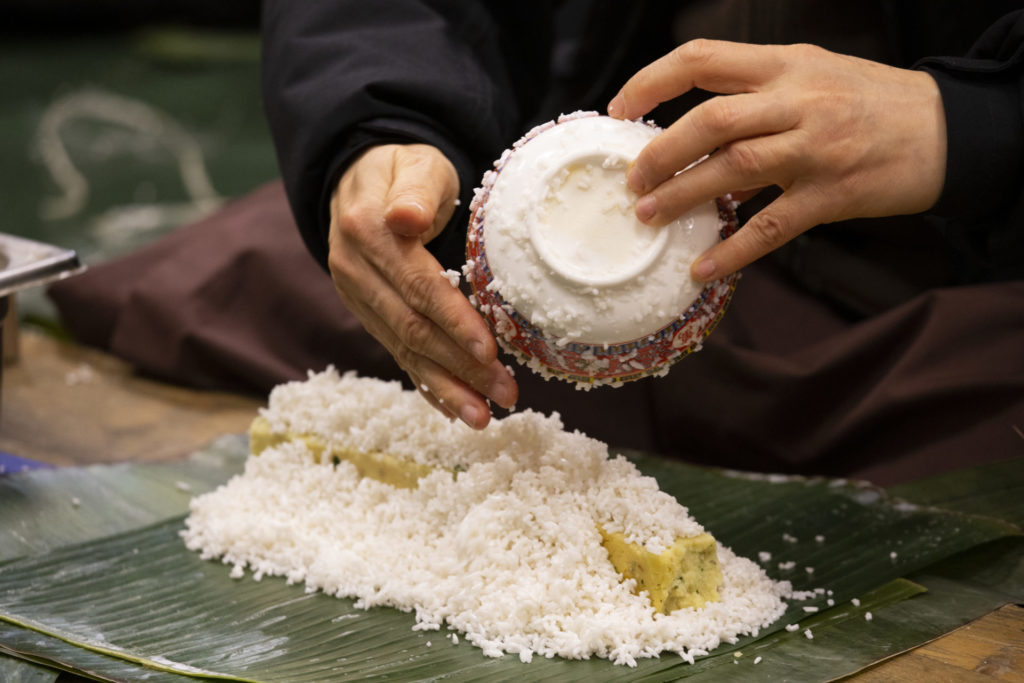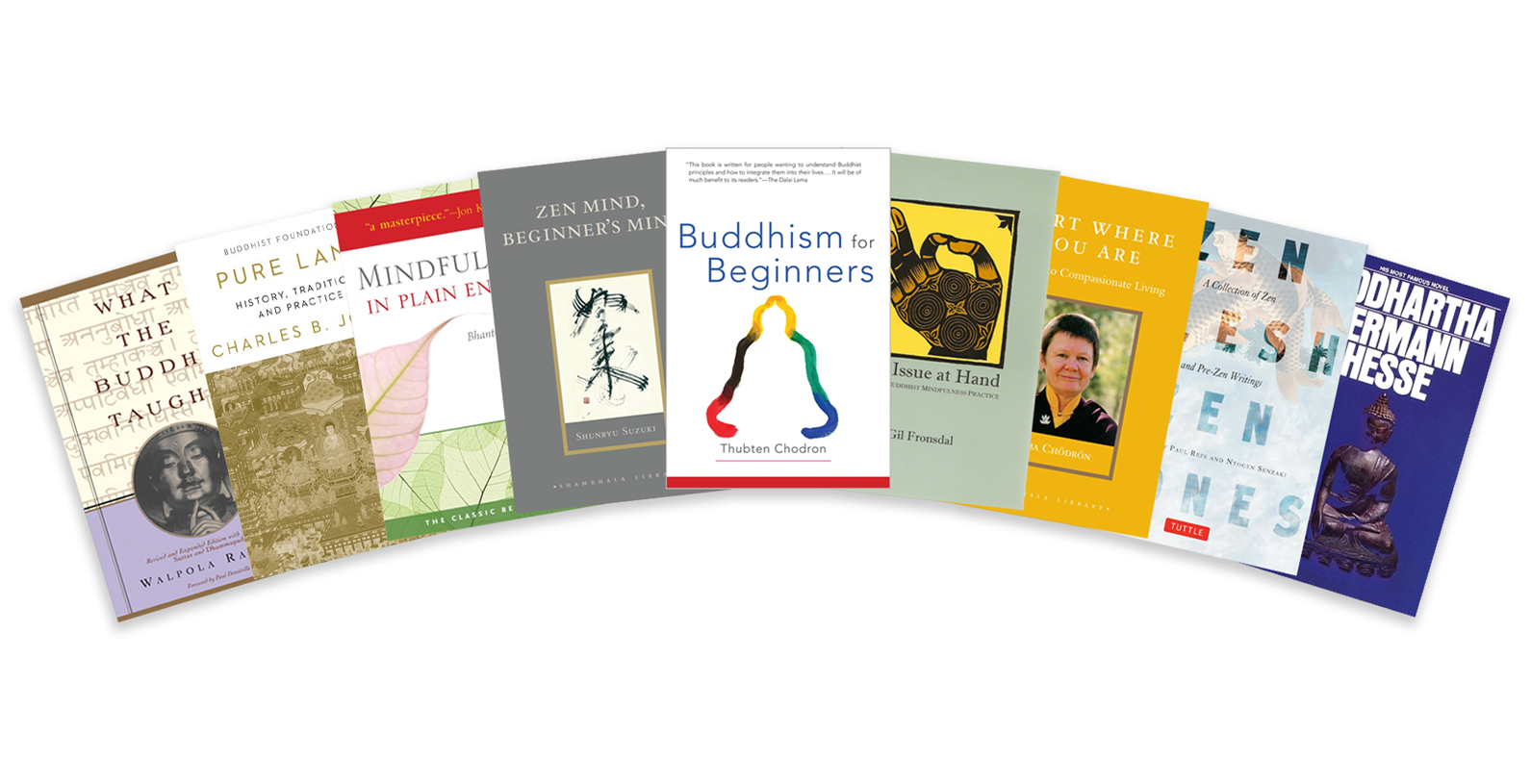Simhamukha Dakini, the supremely ferocious remover of obstacles, Sengdongma, snow-lion-faced Dakini, whose roar defeats all negativities, curses, obstacles or evil forces
Amongst the most powerful, rapid, and awe-inspiring of the Wisdom Dakinis is Glorious Simhamukha, the Snow-Lion faced Dakini. Her mantra is often the first one chanted when a yogi practitioner feels threatened by any crushing supernatural or psychological threat,...
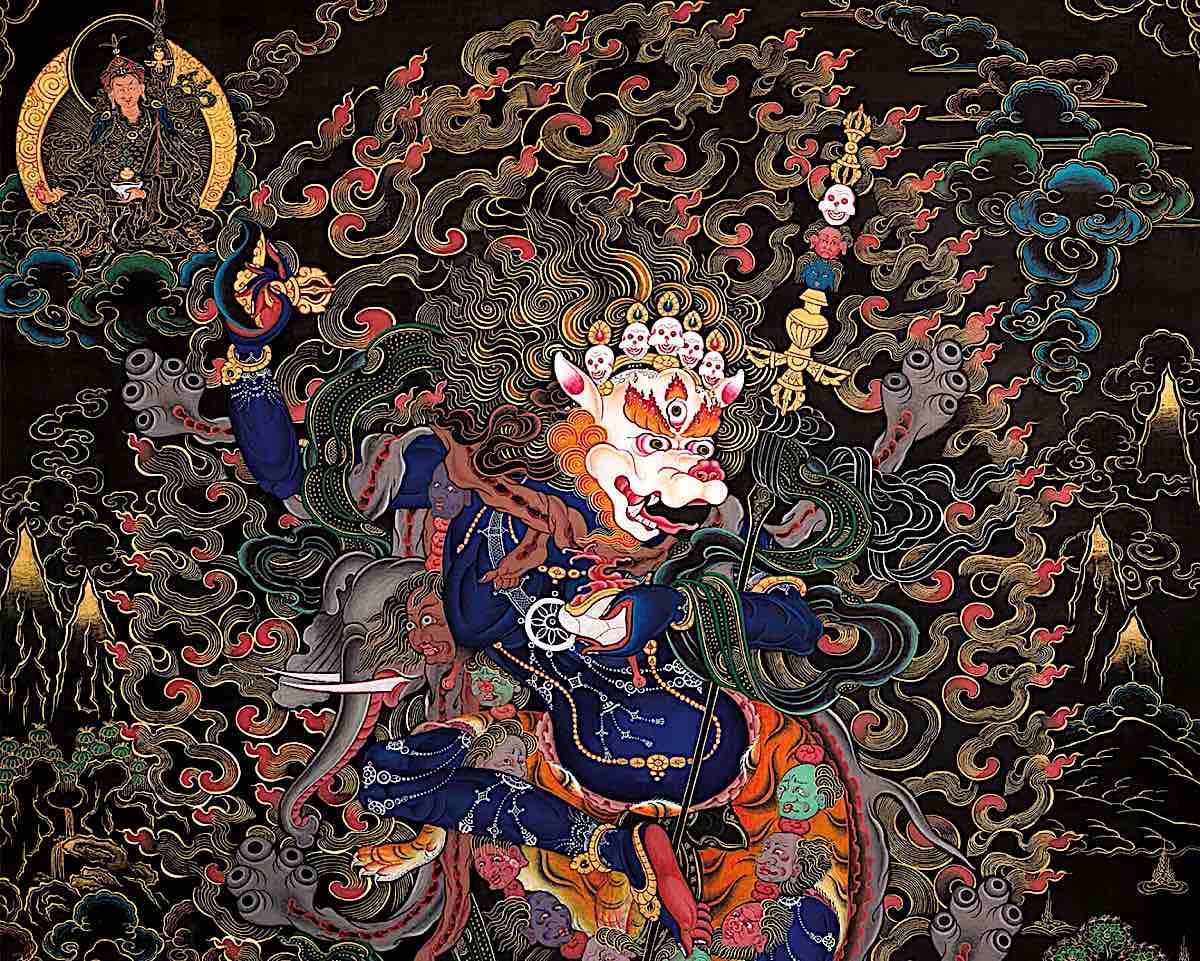
Amongst the most powerful, rapid, and awe-inspiring of the Wisdom Dakinis is Glorious Simhamukha, the Snow-Lion faced Dakini. Her mantra is often the first one chanted when a yogi practitioner feels threatened by any crushing supernatural or psychological threat, including curses — perceived or real is irrelevant — negative karma ripening, ill-wishes, bad luck.. you, get the idea.
She’s the specialist in the darkest of threats and dangers. So fearsome is her appearance, wrath and mantra that threats simply disintegrate to emptiness.
Despite her wrathful, exotic form, Simhamukha, the Snow Lion-Faced-Dakini (Sanskrit: Siṃhamukhā; Tibetan:sen-ge’i gdong ma or senge-dong-chen) is a Jnana Dakini or wisdom goddess. She is among the most popular of the Enlightened Buddhist Dakinis — in part due to her exotic and ferocious appearance.
 Simhamukha, Sengdongma, the Lion-Faced Dakini, is a Highest Yoga Tantra Yidam in Tibetan Buddhism.
Simhamukha, Sengdongma, the Lion-Faced Dakini, is a Highest Yoga Tantra Yidam in Tibetan Buddhism.
Sometimes just called Lion-Faced Dakini, she is found in most lineages and many cycles of teaching and is famous as the most supremely wrathful wisdom Dakini, who can defeat any negativity, curses, obstacle, or evil intentions. [Don’t miss the full story of the great Lotsawa Baripa, in full below!]
Lions represent more than ferocious power. They literally represent Buddha Dharma. The “Lion’s Roar” is synoymous with awakening to the Dharma. “Lion-face Dakini” literally can mean the wisdom that “illuminates the darkest corners.”[6]
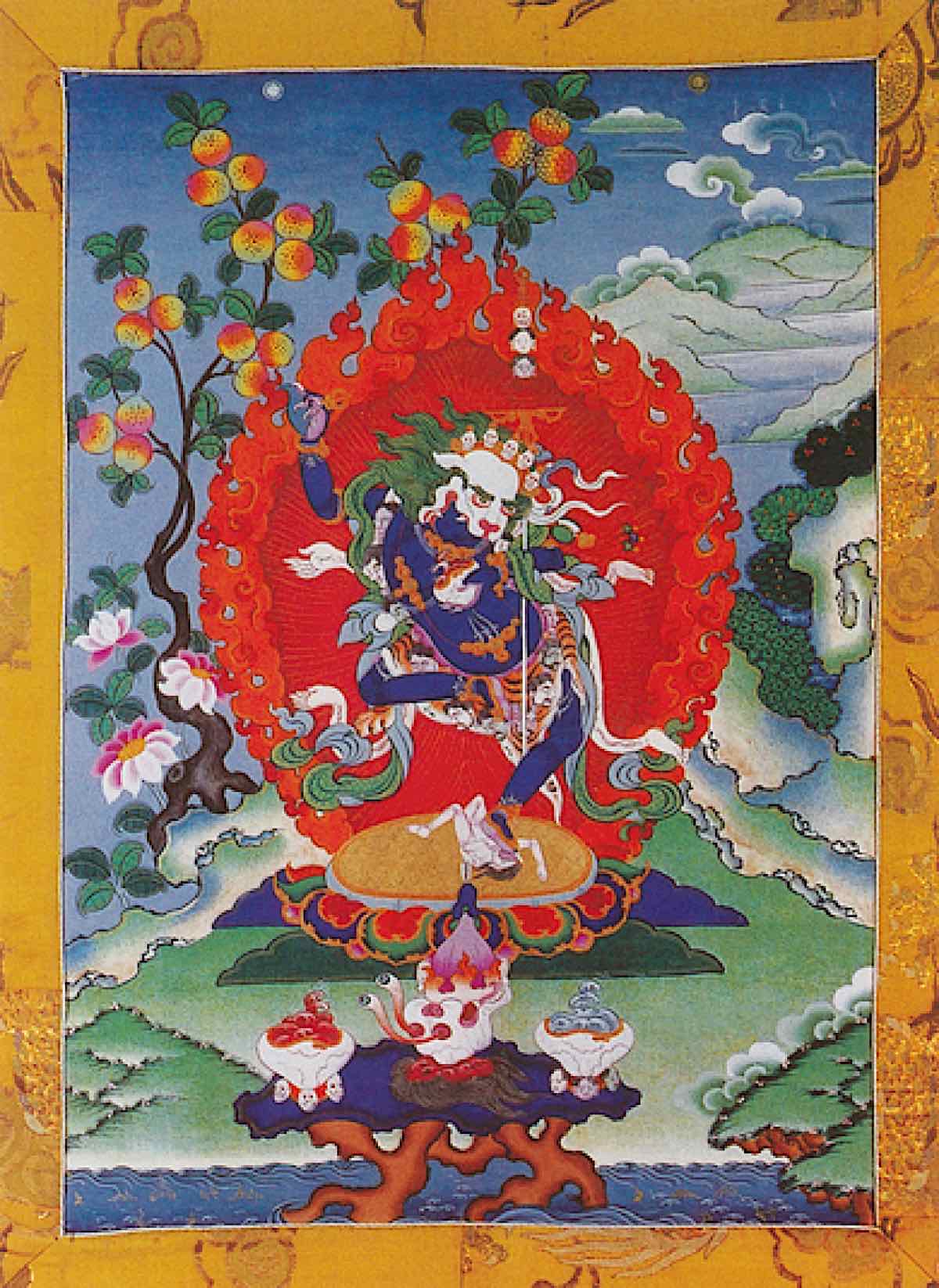 Simhamukha, the Lion-Faced Dakini, is a Highest Yoga Tantra Yidam in Tibetan Buddhism. Here, she appears with a “green mane” and hair and white face — symbolizing the Snow Lion. In other depictions she has wrathful red hair.
Simhamukha, the Lion-Faced Dakini, is a Highest Yoga Tantra Yidam in Tibetan Buddhism. Here, she appears with a “green mane” and hair and white face — symbolizing the Snow Lion. In other depictions she has wrathful red hair.
Why the Lion Face — you call the lion only once!
Milarepa wrote [6]:
“When you run after your thoughts, you are like a dog chasing a stick: every time a stick is thrown, you run after it. Instead, be like a lion who, rather than chasing after the stick, turns to face the thrower. One only throws a stick at a lion once.”
Lion-Faced Dakini is the “only once” deity. Those who call on her only once, can be assured of her help. He help is wrathful, however, so expect an energetic, unexpected result.
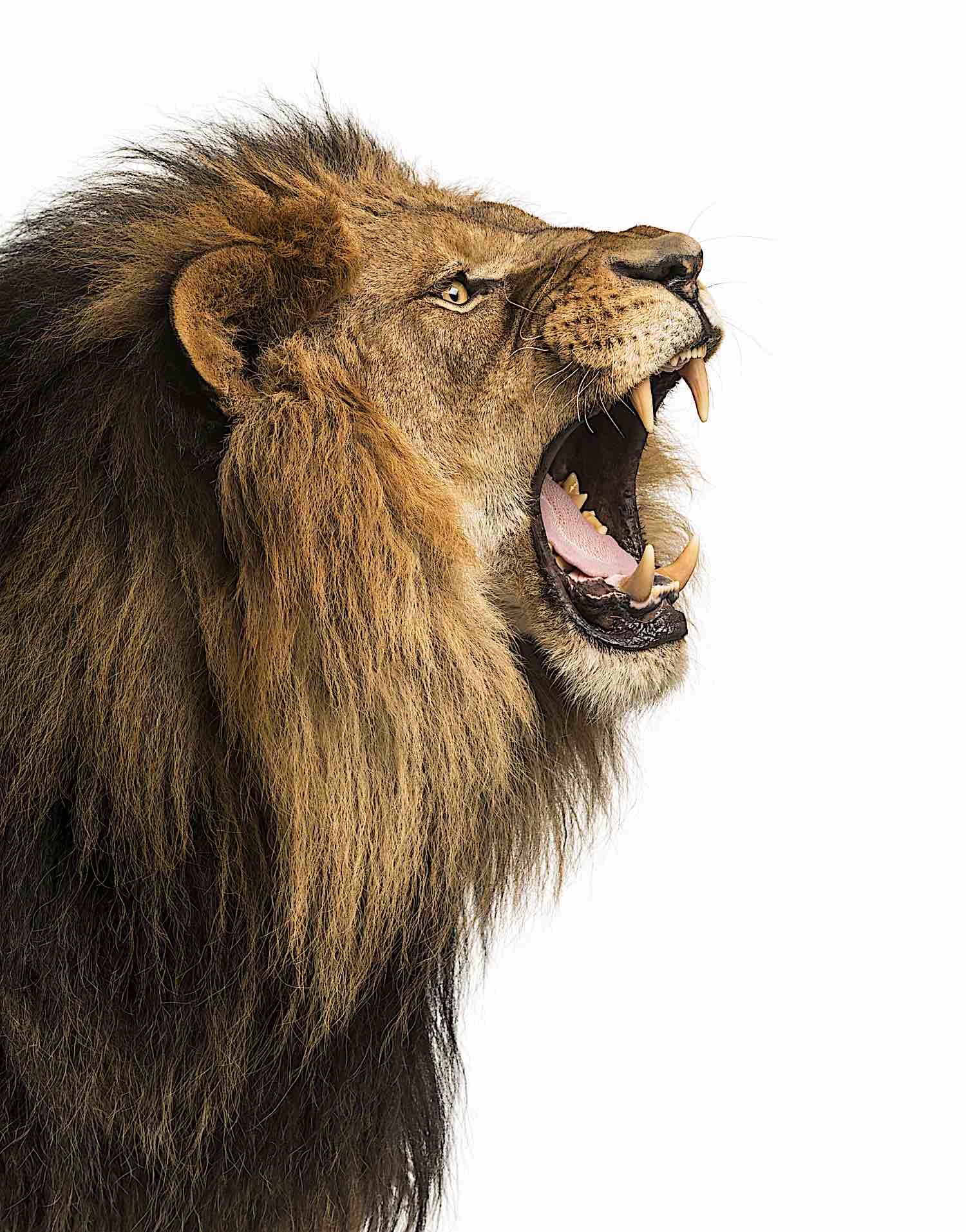 There’s a reason the lion head is symbolic of Dharma awakening. The profound sound of a lion — especially in the wilds — is enough to wake anyone. It’s also enough to send even the most ferocious demon cowering.
There’s a reason the lion head is symbolic of Dharma awakening. The profound sound of a lion — especially in the wilds — is enough to wake anyone. It’s also enough to send even the most ferocious demon cowering.Both Shakyamuni Buddha and Guru Rinpoche are associated with the “lion.” Dharma speech is called the “Lion’s Roar.” There are many profound reasons Simhamukha appears with a lion face. [More on this in the section on symbolism below.]
Why look to Simhamuka for help?
All Wisdom Dakinis are sky-goers. Their rituals are powerful Dharma practices. They are known for “instant” transformation and speedy activity — at the “speed of thought.” Among the Dakinis, the most wrathful of them all, associated with overcoming any adversary, is the Lion-Faced Dakini.
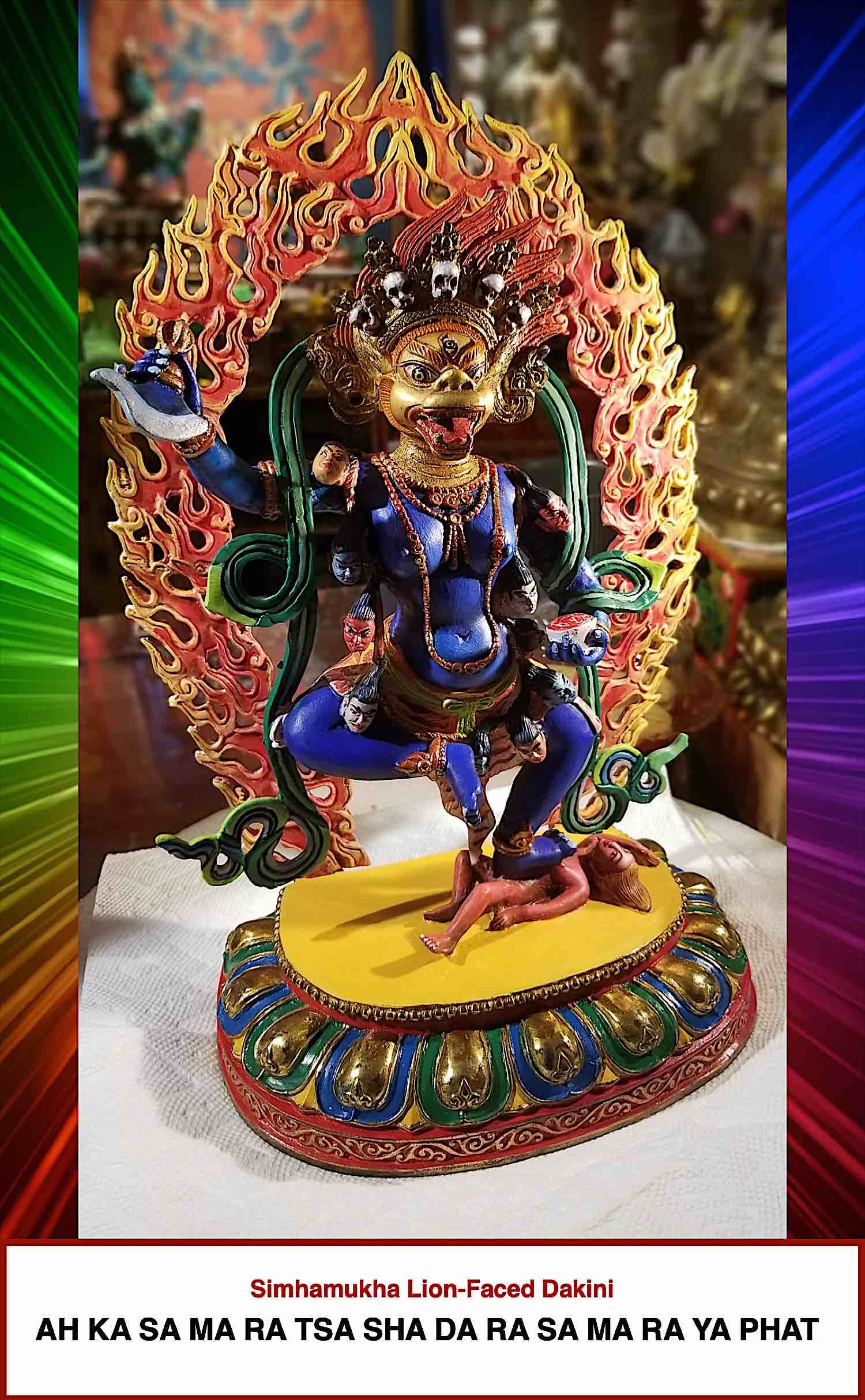 A statue of Simhamukha with her mantra. This beautiful statue was thangka painted as a devotional practice by Buddha Weekly’s own Creative Director Kam Wai Yu. SEE THE NOTE ON MANTRAS below.
A statue of Simhamukha with her mantra. This beautiful statue was thangka painted as a devotional practice by Buddha Weekly’s own Creative Director Kam Wai Yu. SEE THE NOTE ON MANTRAS below.
Like the Lotsawa Baripa — in the story below — we may consider her practice when we are in urgen need of ferocious help. She is considered the “blazing fire of pristine awarness” who can overcome any evil, sickness, misfortune, obstacle, curse, or negativity — especially of an “urgent” nature. When the great yogi Baripa’s life was threatened, it was Simhamukha who rescued him.
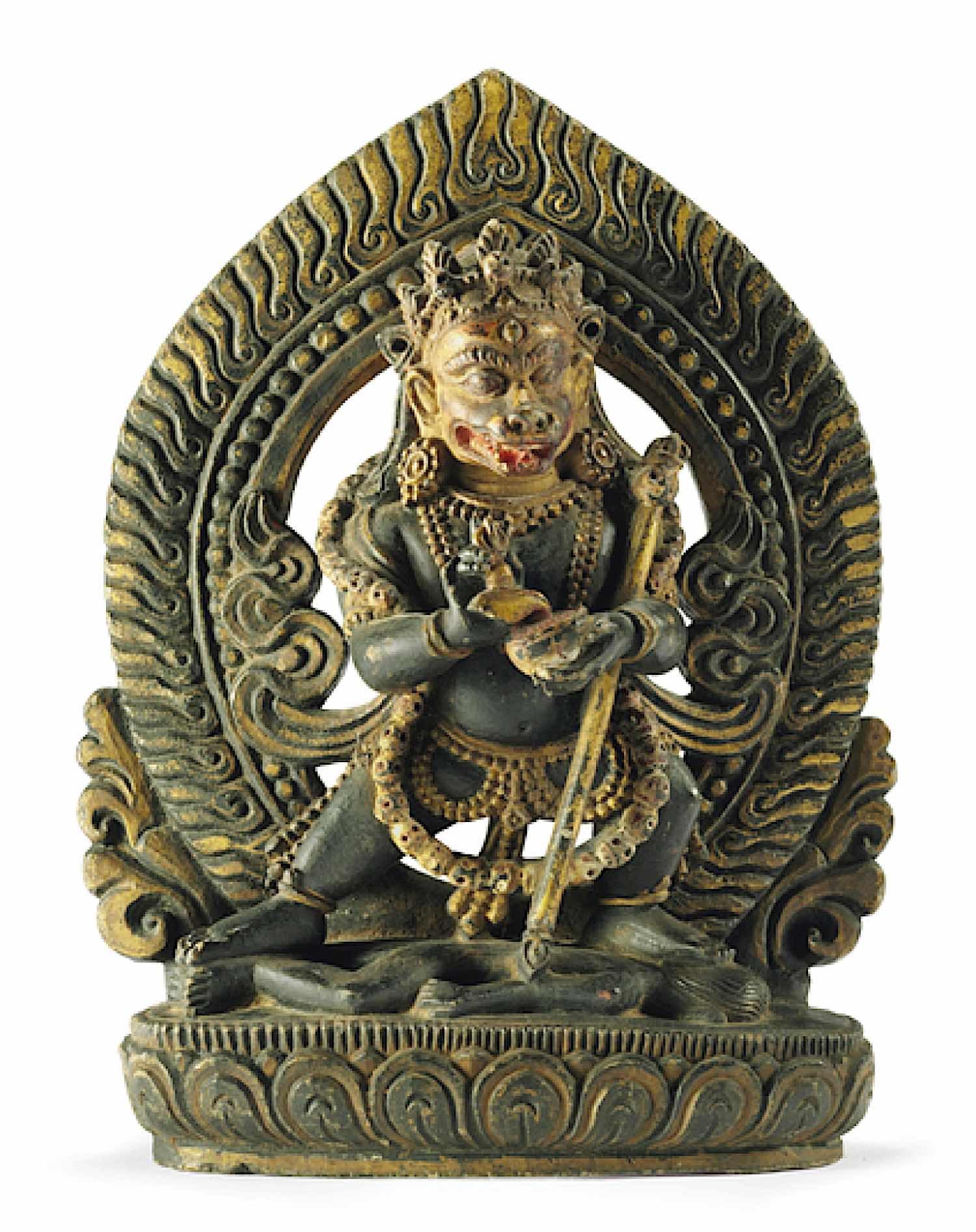 A very old Simhamukha statue in the Himalayan Art collection.
A very old Simhamukha statue in the Himalayan Art collection.
Simhamukha — the Highest Tantra Yidam
In the Chakrasamvara cycle of Tantras, Simhamukha is of the Highest class of Yidam practice — Anuttarayoga ‘Wisdom’ classification — similar to Vajrayogini, Chakrasamvara, Hayagriva and Yamantaka. Like Vajrayogini, she is a “Sarva Buddha Dakini” — more-or-less translated as the “Dakini with the essence of all the Buddhas.”
Lama Tsultrim described Simhamukha as “known as a powerful remover of obstacles and as Queen of the Dakinis.”[5]
Author Vajranatha describes Lion Faced Dakini this way[2]:
“In terms of these Higher Tantras, a meditation deity (yi-dam lha) who is both wrathful and female is the Jnana Dakini Simhamukha. It is important to understand that, despite her exceedingly wrathful appearance and animal head, she is not a guardian spirit (srung-ma), subdued by magic, converted to the Dharma, and bound by oaths of service by some powerful Mahasiddha in the past. Rather, she is a wrathful manifestation of Guhyajnana Dakini, who, according to the Nyingmapa tradition, was the principal Dakini teacher of Padmasambhava in the country of Uddiyana. Therefore, although Simhamukha is a Dakini in her aspect, she functions as a Yidam or meditation deity and her special functions are averting and repulsing (bzlog-pa) psychic attacks that may assault the practitioner and the subduing of negative female energy as personified by the Matrikas or Mamos… Simhamukha appears in a form wrathful, feminine, and demonic; indeed, her form is said to be actually that of a Matrikia or Mamo, not because her nature is evil or demonic, but because her wrathful aspect (khro gzugs) skillfully overcomes and subdues those violent negative energies.”
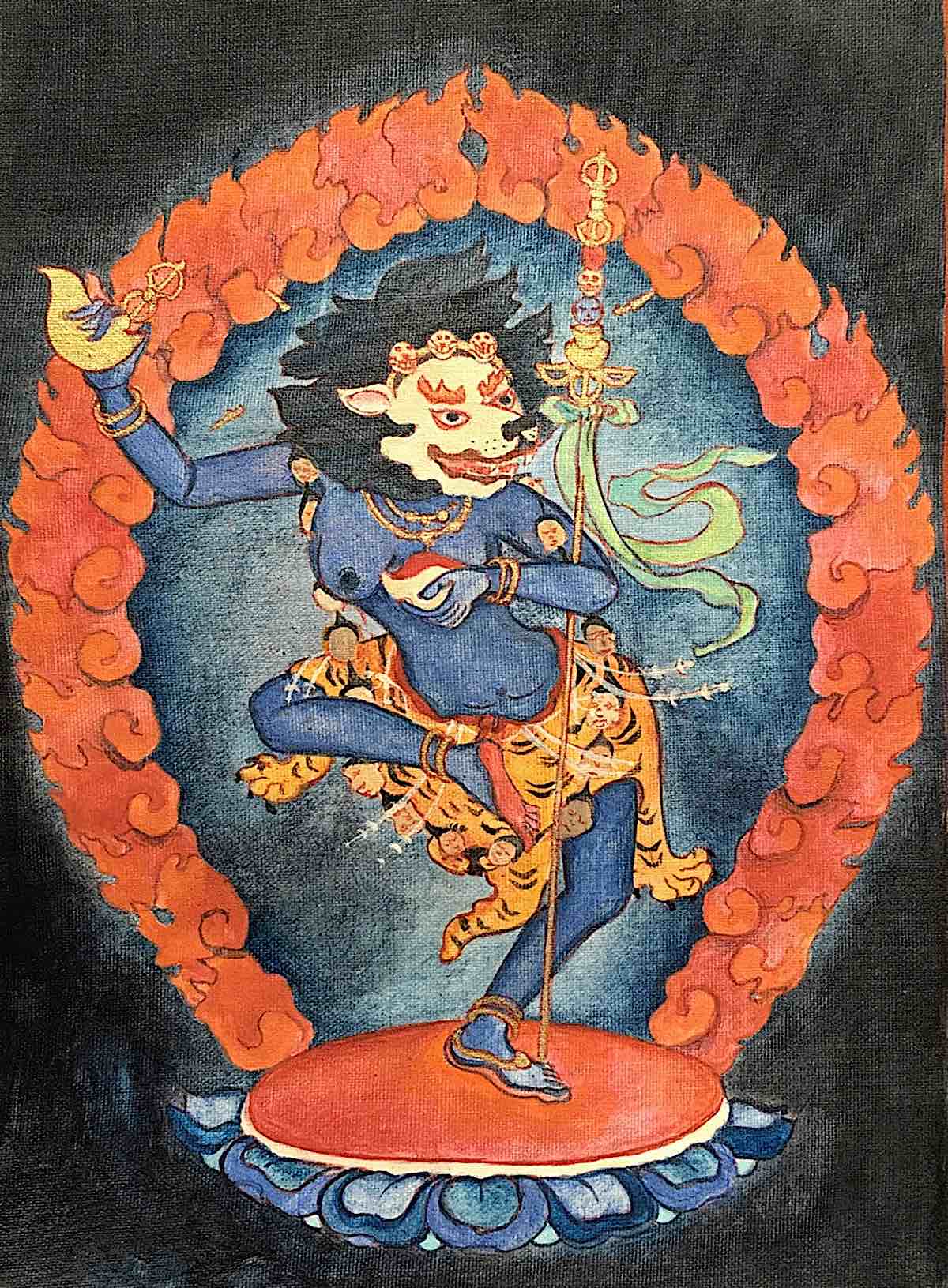 Beautiful Simhamukha art by Laura Santi Sacred Art, used with kind permission.
Beautiful Simhamukha art by Laura Santi Sacred Art, used with kind permission.
Wrathful Lion-Faced Dakini: Nirmanakaya manifestation
Simhamukha is also known as the ‘Wrathful Lion-faced Dakini’, her name literally meaning ‘Lion-faced’. She is wrathful in appearance but compassionate in nature, and is believed to be an emanation of Padmasambhava, the great 8th century tantric master who is credited with bringing Buddhism to Tibet.
“According to Jigmed Lingpa (1726-1798), the famous Nyingmapa master and discoverer of hidden treasure texts or Termas, Simhamukha represents a Nirmanakaya manifestation, appearing in time and history, whereas her Sambhogakaya aspect is Vajravarahi and her Dharmakaya aspect is Samantabhadri, the Primordial Wisdom herself.” [2]
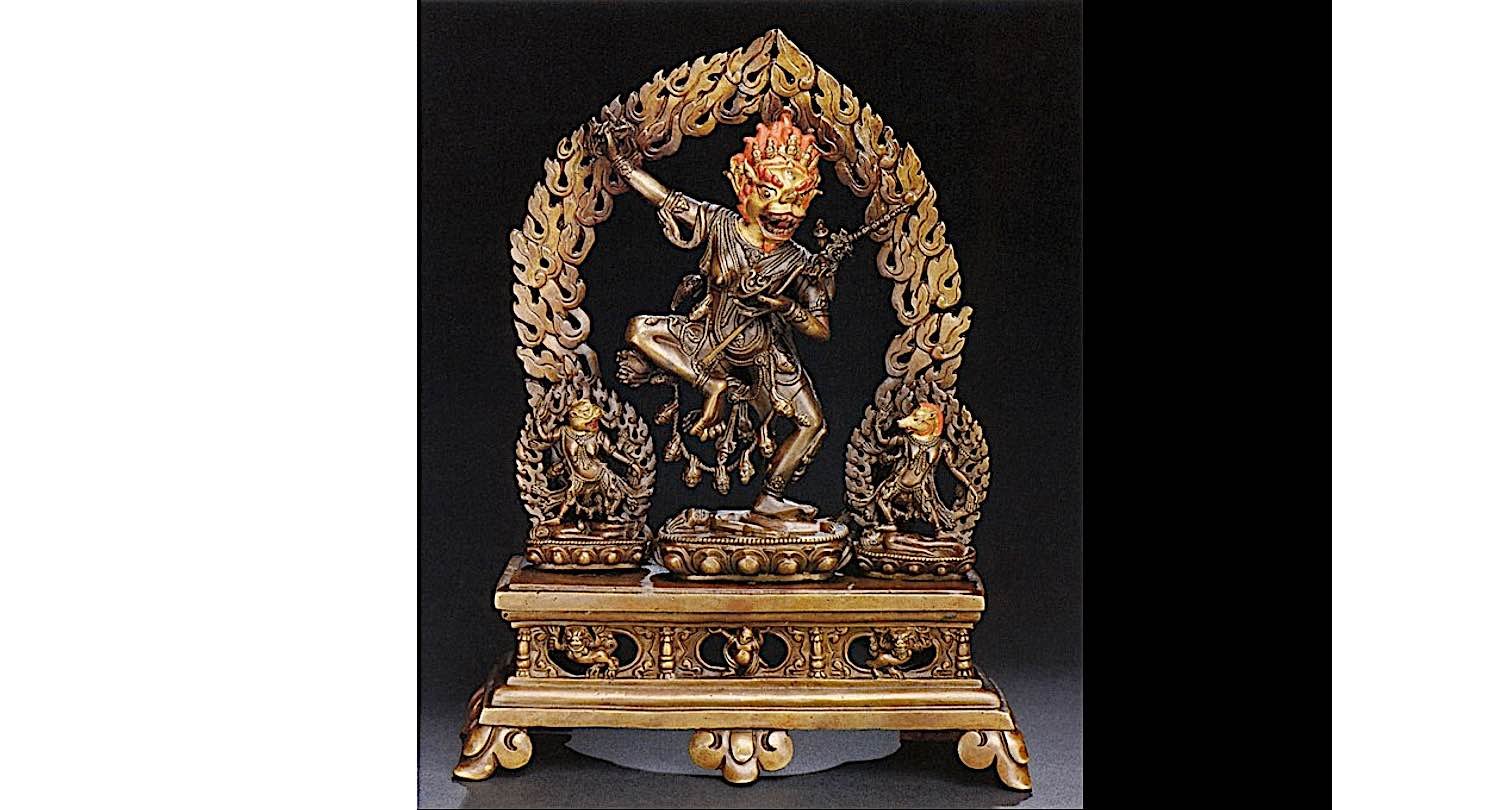 Simhamukha, the Lion-Faced Dakini, from the Himalaya Art collection.
Simhamukha, the Lion-Faced Dakini, from the Himalaya Art collection.
In the Kagyu, Sakya and Gelug traditions, Sengdongma, or Simhamukha, is found in the Charkasamvara tantras, first seen as a chief attendant of Vajrayogini. In the Nyingma tradition, Sengdongma is considered a secret emanation of Guru Rinpoche Padmasambhava. [More on this later.] In addition, Simhamukha is also found in Hindu sacred teachings, often as Simhalalata — although, again, this should be considered a “separate” deity at the relative level. [Ultimately, all are oneness.]
Just to make the topic even more complex, Simhamukha is often confused with Simhavaktra and also with the class of Bardo dakinis with lion-heads. [See the section on this topic below.] Simhamukha, as we’re discussing in this feature, is typically considered a Highest Yoga Tantra Yidam.
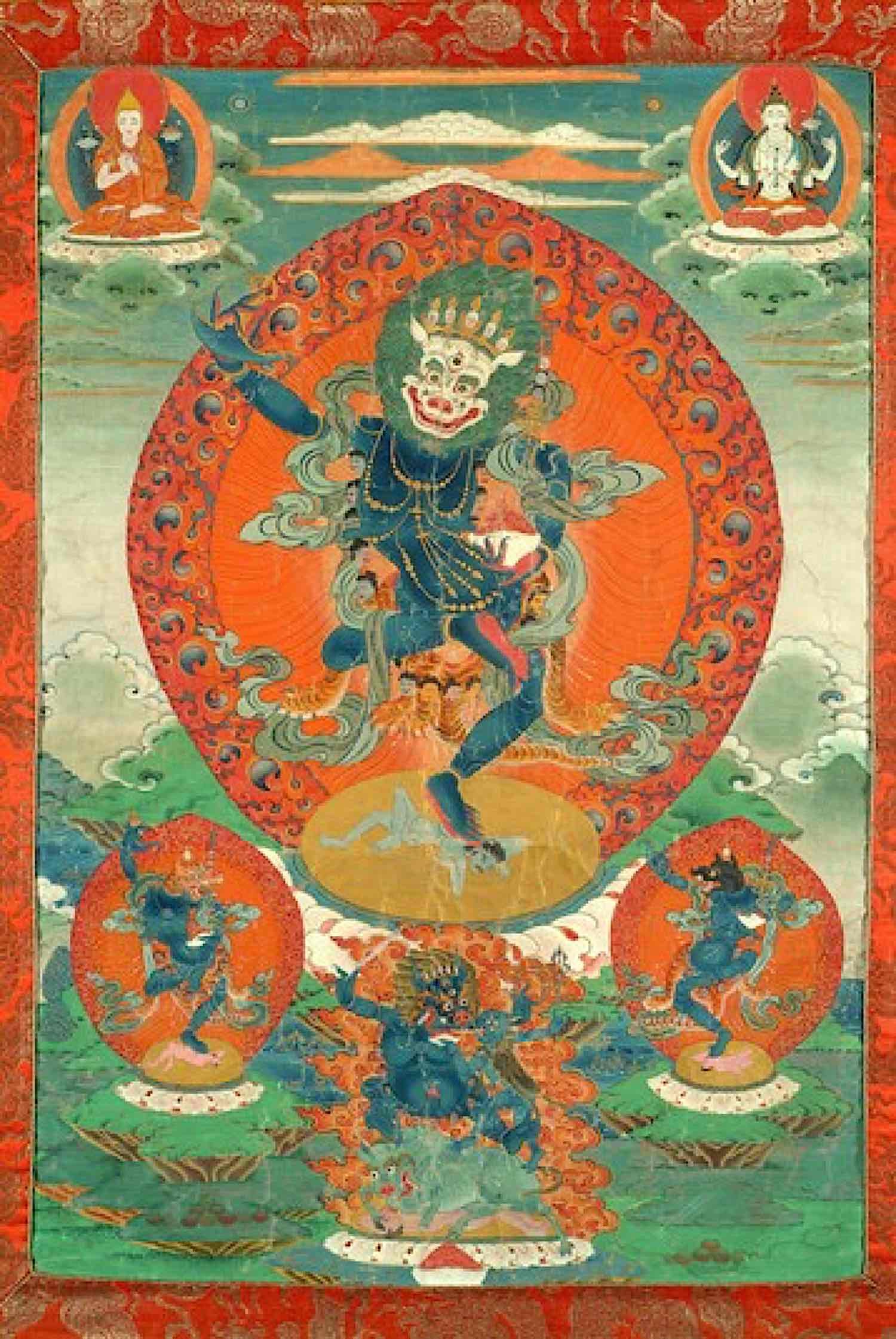 Simhamukha, Lion Faced Dakini, from the Himalaya Art collection.
Simhamukha, Lion Faced Dakini, from the Himalaya Art collection.
Supreme remover of obstacles
Simhamukha’s ferociousness should not be misunderstood; she lures negativities out of their hiding places so they can be destroyed. This is why she is considered the supreme remover of obstacles. It is said that even the mere recitation of her mantra has the power to remove all hindrances from one’s life and path.
Simhamukha is also a popular yidam, or meditational deity, in Tibetan Buddhism — and is the form of an extremely wrathful wisdom Dakini. She is often depicted with blue skin and two arms, holding a vajra (thunderbolt) and a skull cup filled with blood in her two upper hands, while her lower hands hold a kartrika knife and a heart. She usually wears a garland of fifty freshly severed human heads, and her hair is wildly flowing.
Simhamukha mantra chanted by Khen Rinpoche:
Simhamukha’s wrathful appearance is not only designed to strike fear into the hearts of negativities, but also to symbolize her complete victory over them. In Tibetan Buddhist iconography Simhamukha is typically shown trampling on the Lord of Death, Yama Dharmaraja, under her feet.
Simhamukha is also known as the ‘Queen of Space’ or ‘Dakini of Pure Space’, and her blue skin is said to represent the vastness and clarity of empty space. Like all dakinis, she is a powerful symbol of feminine energy, wisdom and transformation.
According to Himalayan Art:
“The dakini Simhamukha is a female meditational deity with a lion face. In the Sarma traditions (Sakya, Kagyu, Gelug) she arises out of the Chakrasamvara cycle of Tantras and belongs to the Anuttarayoga ‘wisdom’ classification. The Sarma tradition Simhamukha is somewhat unrelated to the deity of the same name and appearance in the Nyingma tradition, although the Nyingma Simhamukha is based on the Sarma tradition of Bari Lotsawa according to Nyangral Nyima Ozer. In the Nyingma ‘Treasure’ tradition Simhamukha is regarded as one of the many forms of Padmasambhava, specifically a ‘secret’ form of Guru Rinpoche within the system of outer, inner and secret manifestations.”
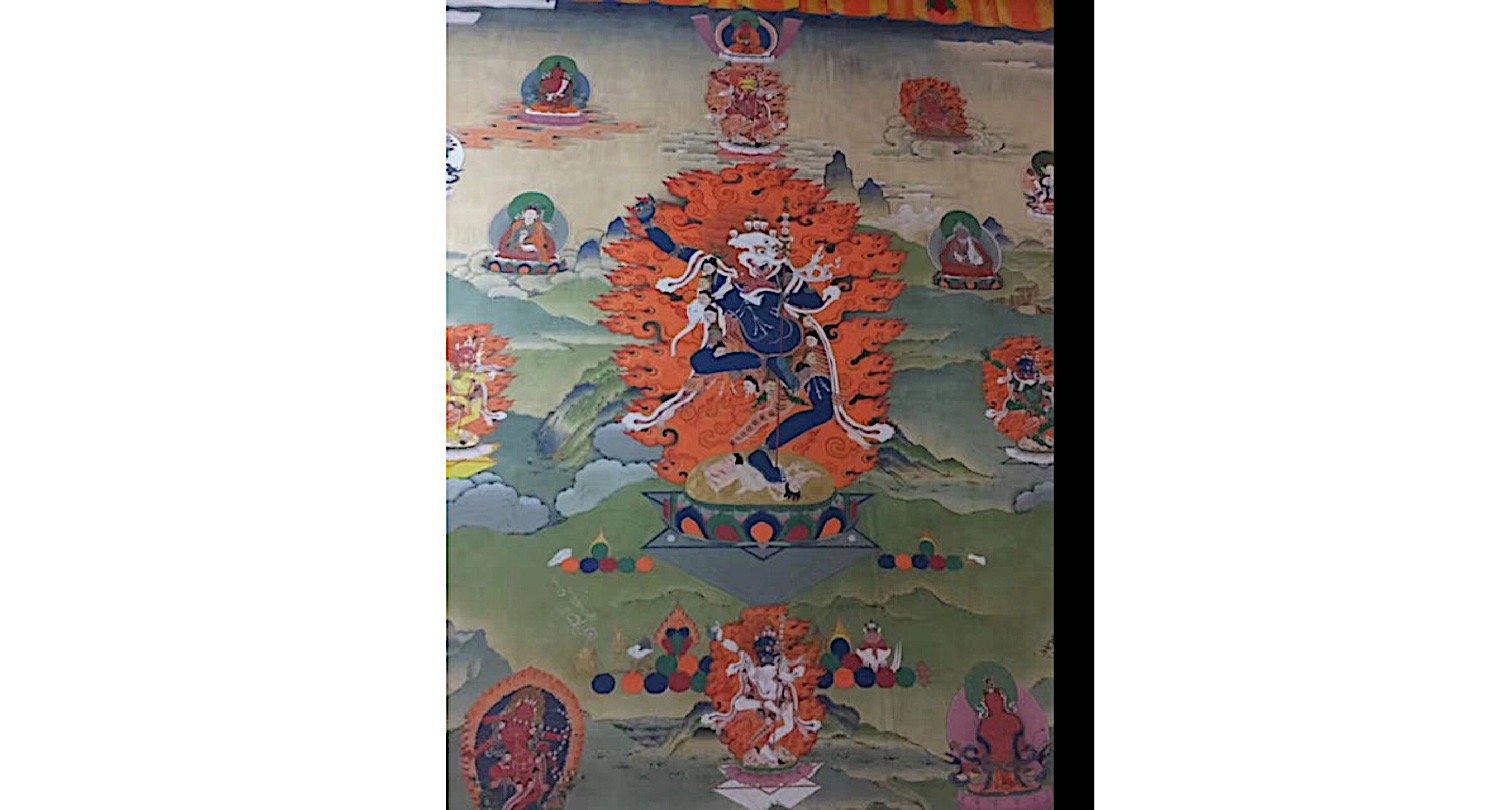 Simhamukha, the Lion-Faced Dakini, Himalayan Art.
Simhamukha, the Lion-Faced Dakini, Himalayan Art.
Why Meditate with Simhamukha?
According to Vajranatha: “Transcendent deities like Simhamukha are emanations or projections of enlightened beings and being archetypes they may serve as meditation deities. These figures are principally classified into three types, because meditation on them the serve as antidotes to the three principal poisons that afflict human consciousness:
1. meditation on peaceful tranquil deities transforms confusion,
2. meditation on wrathful deities transforms anger, and
3. meditation on lustful or joyous deities transforms desire.” [2]
[See her mantras — more than one — below.]
Video on Simhamukha by Khenpo Drimed Dawa
Simhamukha and Simhavaktra — are they different?
SImhamukha and Simhavaktra are often considered to be different emanations or deities. Simhamukha is typically a Yidam deity, a full enlightened wisdom Dakini who is a central focus of many practitioner’s meditaiton. Simhavaktra, on the other hand, is the lion-faced deity who is a fierce attendant of Palden Lhamo, together with Makaravaktra. [Palden Lhamo, the supreme Enlightened protector of Tibet. For a feature on Palden Lhamo, see>>]
Simha (सिंह), in Sanskrit literally means “lion. “
Mukha (“face”) refers to one of the several “attributes” (āyudha) or “accessories” of a deity.
Dakini generally translates as Sky-goer.
Vaktra वक्त्र translates as “mouth” or sometimes “face”
Although both are Dakinis, Simhamukha is usually considered a discrete entity. In fact, there are other “lion-faced” dakinis — often called Khandum.
Simhamukha (Sanskrit) or Sengdongma (in Tibetan) is also the name typically used to describe Guru Rinpoche’s most secret form.
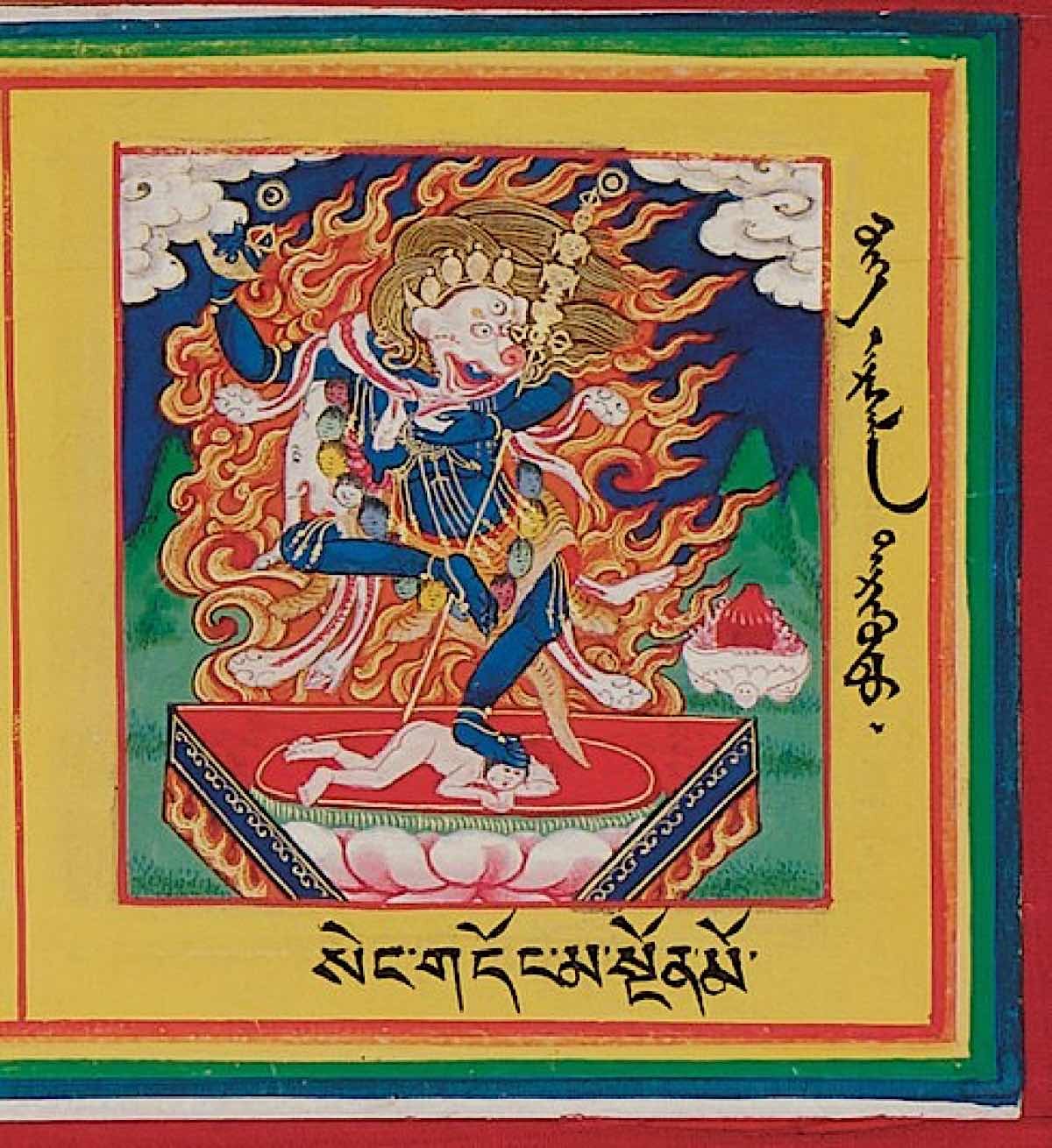
Simhamukha and the Bardo Khandum
Simhamukha is a Yidam deity of the Highest Yoga Tantra class — at least in the context we’re discussing here — and should not be conflated with the Khandum — translates as wrathful dancing Dakinis — that we all meet in the Bardo on the “13th day”. We meet these amazing Dakinis in the Tibetan Book of the Dead. Joseph Houseal explains:
“The dakinis are female, wrathful, animal-headed deities of meditation and the bardo intermediate state after death. They are part of the mandala of the Hundred Wrathful and Peaceful Deities, an archetypical schematic of the human psyche assigning 42 peaceful deities to the heart, and 58 wrathful deities to the mind.”
Among these eight Htamenmas (representing the eight “regions of the brain” are one dark-brown lion-headed one. (Simhamukha on the other hand is typically snow-lion faced (or white faced.) The other animal headed Kerimas are the red-tiger headed one, black fox-headed one, yellow vulture-headed one, dark-blue wolf-headed one, as described in this translation from chapter 13 of the Tibetan Book of the Dead:
“O nobly-born, from the Circle outside of them, the Eight Htamenmas of the [eight] regions [of the brain] will come to shine upon thee: from the east, the Dark-Brown Lion-Headed One, the hands crossed on the breast, and in the mouth holding a corpse, and shaking the mane; from the south, the Red Tiger-Headed One, the hands crossed downwards, grinning and showing the fangs and looking on with protruding eyes; from the west, the Black Fox-Headed One, the right [hand] holding a shaving-knife, the left holding an intestine, and [she] eating and licking the blood [therefrom]; from the north, the Dark-Blue Wolf-Headed One, the two hands tearing open a corpse and looking on with protruding eyes; from the south-east, the Yellowish-White Vulture-Headed One, bearing a gigantic [human-shaped] corpse on the shoulder and holding a skeleton in the hand; from the south-west, the Dark-Red Cemetery-Bird-Headed One, carrying a gigantic corpse on the shoulder; from the north-west, the Black Crow-Headed One, the left [hand] holding a skull-bowl, the right holding a sword, and [she] eating heart and lungs; from the north-east, the Dark-Blue Owl-Headed One, holding a dorje in the right [hand], and holding a skull-bowl in the left, and eating.”
Clearly, Simhamukha is discrete — or at least visualized differently — from the Bardo lion-faced Dakini and Simhavaktra (from the Palden Lhamo mandala.)
There are, in fact, many lion-faced deities mentioned in various lineages and practices. Simhamukha, as we’re discussing here, is a “discrete” meditational deity who is famous for her irresistible power in overcoming curses, supernatural threats, obstacles to practice — in our current life, as well as the bardo.
Simhamukha’s mantra [Be guided by your own teacher on permission for the mantra. Some teachers indicate it is fine to chant, although it has more “power” with lung transmission from a qualified teacher. Caution: Simhamukha’s Sadhana and self-visualization, however, REQUIRES empowerment.]
Significance of the Lion
Of all the “symbols” in Buddhism, the lion is among the most striking, powerful and profound. A lion’s roar is enough to make anyone cower in fear.
“When Sakyamuni Buddha was born, he pointed one hand to heaven and one hand to earth and said with a lion’s roar: I alone am the honored one in the heavens and on the earth.”
The lion’s roar became synonymous with the Dharma. [6]
Buddha himself was represented by the lion. He was called “The Lion of the Shakya” (Shakya was his people or clan) — and he is frequently depicted sitting on a lion as a throne.
His speech was the “lion’s speech.” His spiritual sons (in Mahayana Buddhism) were “Buddha’s lions.” The symbol of the lion — and the snow lion especially — often appeared with Buddhas and Bodhisattvas. They are also found at temple entrances. What do they symbolize? According to Venerable Jampa Choskyi:
“They roam freely in the high snow mountains without any fear, symbolising the wisdom, fearlessness and divine pride of those dharma practitioners who are actually able to live freely in the high snow mountain of the pure mind, without being contaminated by delusions. They are kings of the doctrine because they have achieved the power to subdue all beings with their great love, compassion and wisdom.”
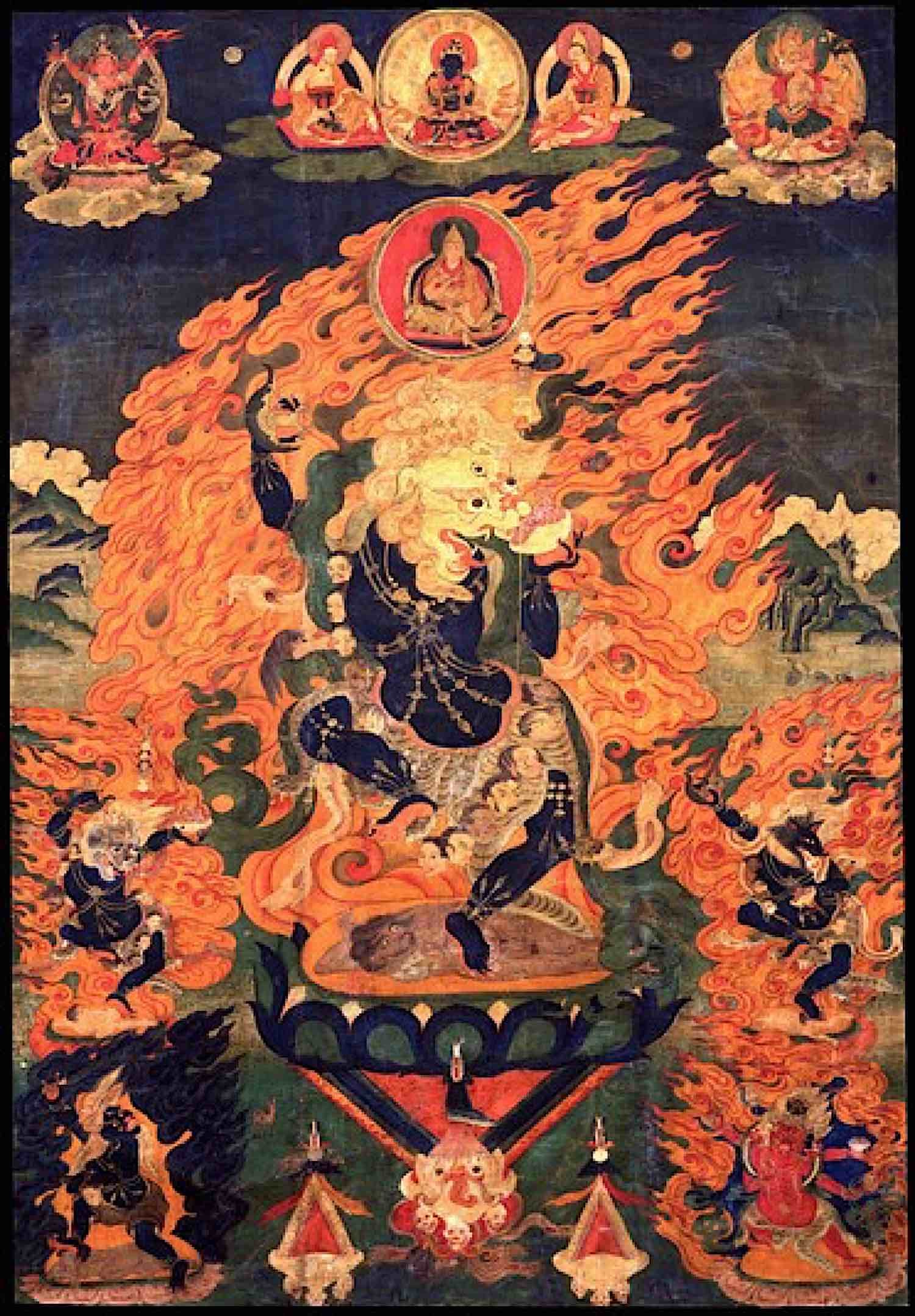 Simhamukha Lion-Faced Dakini of the Bari Lineage, Himalayan Art resource.
Simhamukha Lion-Faced Dakini of the Bari Lineage, Himalayan Art resource.
In Tibetan Buddhism, there is also the symbolism of the “Lion-face Dakini” — wisdom that “illuminates the darkest corners.” [5] In Chinese Buddhism there are not only snow lions, but also lion-dogs — Fu or Fo dogs, usually placed at entrances not only to temples but, also, important institutions.
The importance of the lion as a symbol and a parable continues today. If we can learn to “face the lion” instead of chasing the stick, we would be able to make progress in Buddhist practice.
Simhamukha Mandala
As a ferocious wisdom Dakini, her main form, with black body — often with a white snow face of a Snow Lion — is in the centre of her mandala. In some systems, she is surrounded by four other Simhamukhas, representing each direction and element, similar to the 5 Wisdom Dakinis. Each has a different focus and mantra.
For a feature on the 5 Wisdom Dakinis, see our previous Buddha Weekly feature>>According to John Reynolds [2], “Simhamukha is surrounded by her retinue of four Dakinis who resemble herself, except for their body-color and certain attributes: in the east there is the white Buddha Simhamukha who has the magical function of pacifying circumstances and healing, in the south is the yellow Ratna Simhamukha who has the magical function of increasing wealth and prosperity, in the west is the red Padma Simhamukha who has the magical function of enchanting and bringing others under her power, and in the north is the dark green Karma Simhamukha who has the magical function of vanquishing and destroying negative forces. Each of these aspects of Simhamukha have their own mantras and rituals”
The five are:
Vajra Simhamukha (the main Simhamukha in the centre) who has a black or blue-black body and white face. Buddha Simhamukha in the east, who is white and whose activities are pacifying. Ratna Simhamukha in the south, who is gold or yellow and whose activities are empowering and increasing. Padma Simhamukha in the west, who is red and whose activities are magnetizing and powerful force. Karma Simhamukha in the north, who is green, and who is the supreme activity aspect of Simhamukha.The 5 Simhamukhas are often known as the ‘5 Sisters’. They arose out of the Chakrasamvara tantra and their main purpose is to remove obstacles on the path to enlightenment and to help beings in their spiritual development.
Simhamukha is also one of the 21 Taras, and her specific function is to protect against negativities and obstacles. She is also known as the ‘Green Tara of Melodious Sound’.
Her seed syllable is HUM, which is written in Tibetan script as ཧྲུག་. The HUM symbolizes the indestructible, planet-sized diamond body of Simhamukha which is said to be able to crush anything that stands in her way.
Simhamukha is closely related to Guru Rinpoche. Varanatha wrote: “The famous Terton Ratna Lingpa (Ratna gling-pa, 1403-1479) also discovered many Termas relating to Simhamukha. Similarly, the famous child prodigy Tulku Mingyur Dorge (Mi-‘gyur rdo-rje, 17th cen.), who received the gNam-chos or “sky teachings,” channeled certain hidden treasure texts pertaining to her. Here and in other Termas there are presented different histories of how Padmasambhava received transmissions directly from his Dakini teacher in Uddiyana, Guhyajnana Dakini (gSang-ba ye-shes mkha’-‘gro-ma). One of the eight manifestations of Padmasambhava (mtshan brgyad) is Simha-raurava (Seng-ge sgra-sgrogs), “the roar of the lion,” which is linked with Simhamukha because Padmasambhava recived the transmission from Guhyajnana when he was in that guise. As already said, Simhamukha is regarded as an emanation of this Dakini from Uddiyana.”
The Amazing Story of Great Lotsawa Baripa
One amazing story of Simhamukha’s power is found in The Excellent Vase of Precious Jewels
The Bodong Tradition of the Accomplished Sangye Gönpo by Jamyang Khyentse Wangpo:
“The great lotsawa Baripa of Dring Tsam went to India in order to listen to, study, practice and translate the sūtras and tantras written in Indic languages. Afterwards he travelled to Nepal, where he received teachings from Chiterwa the Newar, and trained and conversed with him. During his stay in Nepal, Baripa engaged in dialogue and debate with the heretic teacher Bhavyarāja. Day after day, Bhavyarāja would defeat the lotsawa and win the debate. Despondent, finally one evening the lotsawa invoked his gurus, iṣṭadevatās and especially Acala and prayed to them for help.
The next morning the lotsawa triumphed in the debate, with the heretic Bhavya experiencing a devastating loss. Bhavya became furious, and warned Master Baripa, saying, “You’ve slipped into a bad habit! Now I will cast spells upon you. You will either be left defeated and humiliated in no more than seven days, or you will be forced by the power of my black magic to accept my teachings!”
The lotsawa was overwhelmed with fear and rushed back to the great scholar Chiterwa. In a trembling voice, Baripa recounted the debate with the heretic Bhavyarāja, saying, “As soon as I won, Bhavya became enraged and told me that he is going to cast evil spells which will destroy me within seven days! And if this is not the case, then the spells will force me to accept his teaching. What should I do?”
The great Newar scholar Chiterwa replied, “O lotsawa! Do not be afraid! It seems you would rather kill yourself than accept this heretic’s doctrine. Now, I will have to send you to India to train in averting the dark arts of life-taking evil spells with the great guru of Vajrāsana.Here, take from this box the powder of swift-footedness and rub it on your feet.”
So Baripa rubbed the powder on his feet, and he reached the Nepali lowlands that very same morning. After merely a half-day’s travel, Baripa arrived at the Vajra Throne.
Baripa then met with the great guru Vajrāsana and presented his letter of introduction from the learned Chiterwa. He also offered one sho of gold as a gift to Vajrāsana and related the story of his debate with the heretic teacher in great detail.
Guru Mahāvajrāsana replied, “O lotsawa! Do not be afraid of the heretic teacher! I have a variety of pith instructions for protection and reversal; one in particular is exceptionally profound and acute. In order to retrieve it, first you must prepare an excellent torma of flesh and blood on the evening of the tenth day of the month. While offering it, one-pointedly invoke and pray to the assembly of the Three Jewels and your gurus, iṣṭadevatās and ḍākinīs. Then at dawn you will receive a prophecy from the ḍākinīs.”
So the lotsawa prepared a gaṇacakra using four sang of gold and undertook the invocation. The gurus, iṣṭadevatās and ḍākinīs paid heed and as a result granted him the following prophecy, proclaiming, “O lotsawa! Do not be afraid of the heretic! We will grant you protection!”
The principle ḍākinī of this assembly was the esteemed wisdom ḍākinī Siṃhamukhā, who counselled him, saying, “The supreme among all pith instructions, combining the red, black and mottled like an ocean of amṛta which annihilates all, lies hidden about one krośa to the south of the Vajra Throne. Search there for an iron boulder that looks like a dead yak. Beneath it you will find black earth in the shape of a triangle. If you dig there you will find a small sealed chest covered by charcoal. Inside of this there is a rhinoceros leather chest. Inside of this there is a chest made of the bodhi-tree wood. This chest contains a silver chest. Within the silver chest is a precious chest of gold. Within the gold chest is a turquoise chest. Inside the turquoise chest is a lapis-lazuli chest. Within this is a ruby chest, within which, wrapped in maroon-coloured silk and human skin, you will find ‘the fourteen-syllable fierce averting mantra’, written with the heart-blood of all ḍākinīs; it does not begin with oṃ, and it does not end with svāhā. It is ornamented by neither i’s nor u’s, neither o’s nor e’s. It is written without spaces between the syllables in one single continuous line. Once you have uncovered it, recite it every day twenty-one times, and you will be protected from all evil spells; you will avert all that is harmful, pacify all adversities and obstacles, and all siddhis and all that is favourable will come to you. If you recite it twenty-one times in the morning and strong disturbing negative thoughts arise, do not recite it any more!”
With those words, Siṃhamukhā vanished without a trace, like a rainbow into thin air.
So the lotsawa left before the break of dawn, carrying with him a large red torma as an offering. Soon he reached a yak-shaped boulder. As instructed, he dug where he found triangular-shaped black earth, and first came forth the charcoal.
Then, as the prophecy foretold, he took out the chests, and so he revealed the life-force mantra of all the ḍākinīs, the pith-instruction which is like an ocean of amṛta. In exchange for the treasure, the lotsawa placed a precious golden text in the chest and then hid it again just as he had found it.
The lotsawa then recited the mantra according to the pith instruction, day and night without interruption.
One day, at dusk, signs arose that the heretic had targeted the lotsawa with black magic, yet all the worldly ḍākinīs and dharmapālas sent by the heretic were unable to harm the lotsawa, so they became ashamed and left. Thus the lotsawa was able to avert the threat.
After the sun had set, the lotsawa managed to avert the cloud of worldly deities and spirits that had gathered. At dawn, the lotsawa was able to avert the cloud of activity ḍākinīs.
Then the esteemed and foremost wisdom ḍākinī Siṃhamukhā appeared once again in the sky before the lotsawa and spoke, “O Baripa, the heretic teacher Bhavyarāja has vomited blood and lives no more!”
Overjoyed, Bari Lotsawa returned to Guru Vajrāsana and shared this news. Guru Vajrāsana replied, “In these degenerate times, fearful sentient beings employ their negative emotions to win arguments. I am one such master,” he lamented, covering his head in disappointment. Moved, Bari Lotsawa prostrated many times before his Guru and confessed, “O Guru! Not only have I averted this evil out of fear, I have also engaged in spells that caused the death of my opponent. So now I must bear the fault of having taken the life of another!”
The great Vajrāsana replied, “It would have sufficed merely to wear the mantra I have spoken of on your body, but you have recited the mantra day and night without interruption! Thus you have accumulated the fault of killing. Now you must exert yourself in purifying this bad deed. Do not return to me until definite signs arise that it has been purified.”
For one whole year, then, the lotsawa exerted himself in purifying this evil, during which time he did not have a single opportunity to meet his guru, the great Vajrāsana. The close disciples of Vajrāsana, without any signs of pride, treated Baripa with great kindness, bringing him food and liquor when possible, along with anything else he needed, all without the guru’s knowing. When signs finally arose that Baripa had purified his evil deeds, and his guru’s command, his wish, had been accomplished and fulfilled, he was once again able to meet his guru.
From then onwards, Baripa requested many teachings and became both learned and faithful. When he returned to Tibet, he benefited beings on a vast scale. Later still, he journeyed to the glorious Sakya monastery and transmitted the pith instructions and related empowerments, sādhanas and activity liturgies to Sachen Kunga Nyingpo.
The instructions on Siṃhamukhā were then transmitted to the precious teacher Jetsün Drakpa Gyaltsen,the great Sakya Paṇḍita,the great Jetsün Phakpa, Nyene Rongpo Dorje, Rongpo Sangye Yeshe, and the precious teacher of Rongpo, the learned Yakde Paṇchen.
Thus the uncommon practice of the wisdom ḍākinī Siṃhamukhā was established. This led many to gain visionary experiences of the deity, while the practice itself brought a constant rain of blessings.
The heart-essence mantra also reached the accomplished lady Jetsünma Timudra; the eminent scholar, the precious Samten Pal Zangpo; the Mantra-holder of the degenerate time, the great Vajradhara, the realized Namkha Sangye Gönpo; Rechen Kunga Darpo, the heart-son Kunga Zangpo; and finally the learned and accomplished master, the kind teacher, speech of infinite teachings, Champa Chökyi Nyima.” [4]
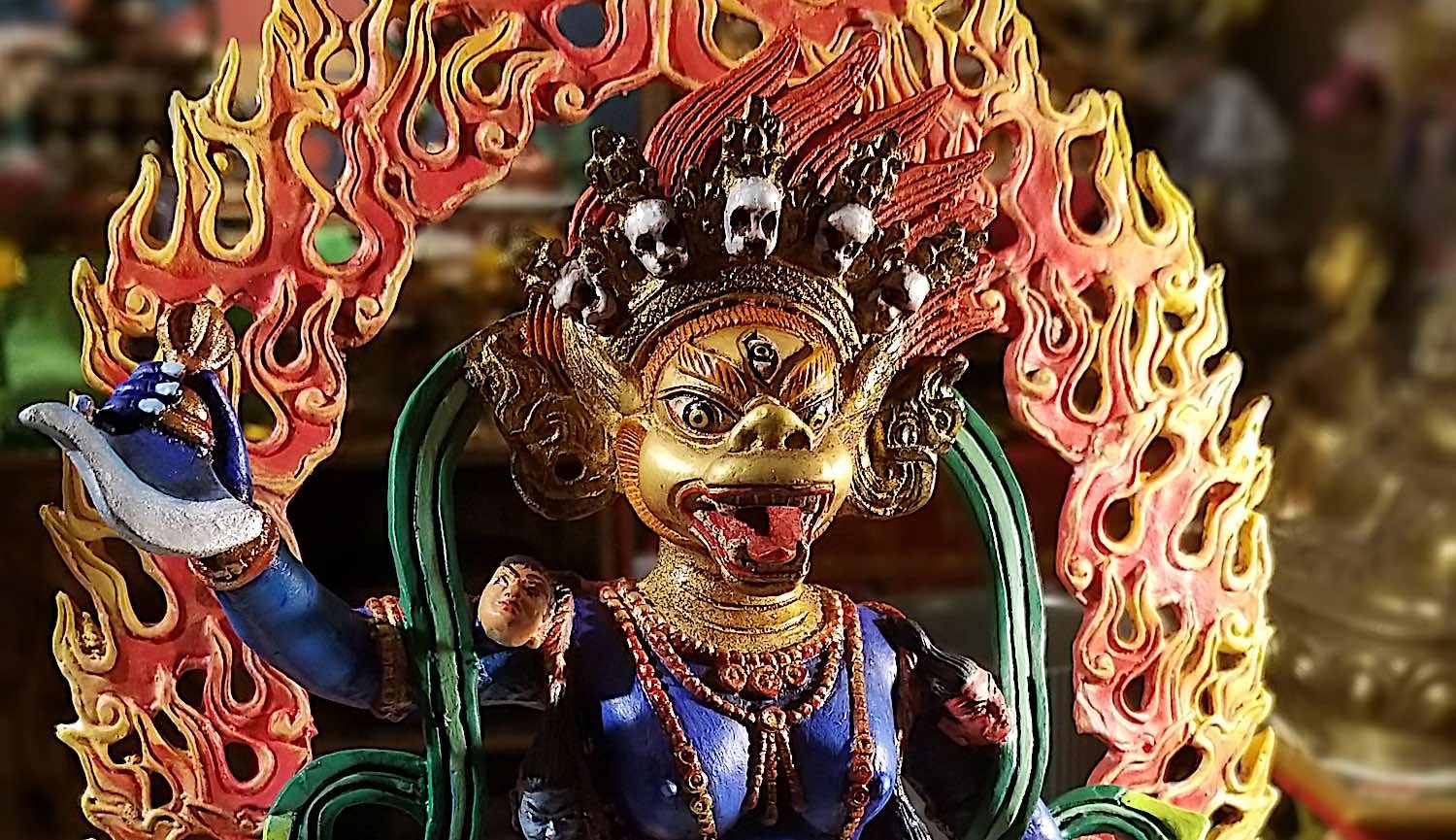 Simhamukha or Senge Dongma, the Lion-Faced Dakini . This is a statue hand thangka painted as an act of devotion by Buddha Weekly’s creative director Kam Wai Yu.
Simhamukha or Senge Dongma, the Lion-Faced Dakini . This is a statue hand thangka painted as an act of devotion by Buddha Weekly’s creative director Kam Wai Yu.
The powerful mantras of Simhamukha
It is for you to decide if you can use the mantra in your meditations without a teacher’s empowerment. Empowerment always makes mantra work more effective. However, it is without question that you may NOT visualize yourself in meditaitons as Simhamukha without permission of the teacher. Always be guided by your own teacher and lineage, as each is different.
[NOTE: Be guided by your own teacher on permission for the mantra. Some teachers indicate it is fine to chant, although it has more “power” with lung transmission from a qualified teacher. Caution: Simhamukha’s Sadhana and self-visualization, however, REQUIRES empowerment.]
Her shortest mantra is
OM SIMHAMUKHA HUM PHAT!
Another of Simhamukha’s mantras is, this one recognizing her as Supreme Dakini (Sarva Buddha Dakiniye) — a title and phrase also found in Supreme Dakini Vajrayogini’s matra — which literally means “Dakini Whose Essence is That of All Buddhas.” (This can be equally said of both Simhamukha as a Highest Yoga Tantra deity and Vajrayogini as a Highest Yoga Tantra deity — there is no contradiction.)
OM SIMHAMUKHA SARVA BUDDHA DAKINIYE HUM PHAT SVAHA.
Reciting this mantra is believed to invoke Simhamukha’s blessings and protection, and to remove all obstacles from one’s life. There is another version of this mantra (found in the “Secret Book of Simhamukha” which drops the Sarva Buddha Dakiniye, as in:
OM VAJRA DAKINI SIMHAMUKHA HUM HUM PHAT
Also from the Secret Book of Simhamukha, is found her Karma mantra:
OM JNANA DAKINI SARVA SIDDHI PHALA HO
In the Excellent Vase of Precious Jewels, her mantra is:
NAMO GURU DAKIN! SIMHAMUKHAYE SARVA SATRUN VIGHNAM MARAYA PHAT
Simhamukha’s 14-syllable protective mantra
Her most ferocious and powerful mantra is [See video below]
AH KA SA MA RA TSA SHA DA RA SA MA RA YA PHAT
Sometimes this is written this way (Cha instead of Tsa — it’s the same, just expressed in Alpha transliteration slightly differently. Phat is sometimes expressed as Pey (Tibetan style):
A-KA-SA-MA-RA-CHA-SHA-DA-RA-SA-MA-RA-YA PHAT
The most popular mantra, by far, recommended by teachers such as Lama Zopa and many others for protection from supernatural threats, major life obstacles, and practice obscurations is this 14 Syllable Mantra.
Sources of her tantra
Chakrasamvara Tantras Hevajra Tantra — where she arises as one of the eight Dakinis who guide us in the intermediates state of bardo, between our lives. Drubpa Kagye (8th century), Padmasambhava Guhyagarba TantraNOTES
[1] Himalayan Art Simhamukha page: https://www.himalayanart.org/search/set.cfm?setID=153&page=3
[2] The Wrathful Wisdom Dakini Simhamukha, Author John Reynolds Vajranatha [Source https://dawnboiani.wordpress.com/2021/01/01/simhamukha-wrathful-lion-headed-dakini/]
[3] Tibetan Buddhist
[4] History of Siṃhamukhā Practice, Lotsawa House https://www.lotsawahouse.org/tibetan-masters/jamyang-khyentse-wangpo/history-of-simhamukha
[5] Tara Mandala blog https://www.taramandala.org/blog/new-june
[6] From Buddha Weekly feature “The Lion’s Gaze and the Lion’s Roar.”>>

 BigThink
BigThink 











